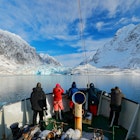

So you’ve watched elephants lumber across the dusty plains of the Serengeti, and spotted Bengal tigers lapping from waterholes deep in the jungles of India. Maybe you’ve viewed polar bears playing in the snow in Canada, or observed sloths doze in the treetops of the Amazon Rainforest. But have you ever considered signing up for a wildlife safari in…Sweden? Welcome to Europe’s most underrated wildlife-watching destination.
Between its vast forests, numerous lakes, and long coastline, Sweden has always been a great place to get back to nature. From hiking blueberry-lined trails to bedding down in quirky off-grid ecolodges, there are plenty of unique ways to experience its unique wilderness. It wasn’t until relatively recently, however, that Sweden’s tourism industry began to capitalise on one of the Nordic nation’s best natural assets: its wildlife. Here are five incredible species you can now to check off on a Swedish safari.

Wolves
Hunted to extinction in the 1960s, grey wolves began returning to Sweden in the early 1980s. Protected since 1966, Sweden’s wolf population now numbers at least 300, with approximately 40 family groups calling the forests of Central Sweden home. While many farmers consider the return of wolves to be a nuisance, Marcus Eldh, wildlife tour guide and founder of Wild Sweden, sees it as a gift.
"It’s not easy to predict where you might see a wolf during the day, but if you can locate a den, you have a good chance of hearing them howl at night, which is a really special experience," says Eldh, Sweden’s only wolf-tracking tour operator.
Working closely with the Scandinavian Wolf Project, which monitors wolf populations in Sweden and Norway, Wild Sweden offers an overnight tour camping in a secret location near Skinnskatteberg, around two hours northwest of Stockholm by train or car. After learning how to identify wolf tracks, droppings and sounds, groups head out on foot to a strategic location within howling distance of a wolf den, from where wolves can be heard making their distinctive call to signal their return from hunting. If you’re lucky, you’ll hear their pups yelp in response.
"Sometimes we hear wolves howl from the camp, too," says Eldh, who claims his tours are perfectly safe. ‘The last deadly wolf attack in the wild in Sweden was in the 1820s," he says.
When to go: Tours run from May to September.

Beavers
Sweden’s endemic Eurasian beavers were also hunted to extinction, killed off for their fur and the castoreum from their scent glands, which was used in perfumes. Declared extinct in 1871, it would be another 50 years before the huge rodents, which weigh up to 25kg, were reintroduced. Sweden’s beaver population now numbers more than 130,000, with a large proportion calling Central Sweden home.
For the best chance of spotting beavers, you’ll need to join a tour by boat or canoe in a beaver-dense area after sundown, when beavers are most active. Ideal for photographers, Wild Sweden conducts its beaver safaris by electric motor boat (which is quieter and more eco-friendly than a petrol motor) near the village of Färna, two-hours' drive northwest of Stockholm, which is home to several beaver families and their lodges (homes). Even quieter and easier on the environment are the evening beaver canoe safaris in the beaver-rich Malingsbo-Kloten Nature Reserve by Nordic Discovery; they are based out of the village of Kloten, 43km northwest of Färna.

‘This silent mode of transport not only allows us to observe beavers closely, but also gives us a chance of spotting moose, deer, fox, badger, hare and plenty of different birds a well," says Mikael Nilsson, wildlife guide and founder of Nordic Discovery. Both operators claim that beavers are sighted on almost every tour, usually seen swimming, snacking on soft plants, and chopping down trees for food and building materials.
When to go: Tours run regularly between May and September, but Nordic Discovery also offers a wintertime version in a waterway where ice doesn’t form.

Moose
With more moose per capita in Sweden than anywhere else in the world, chances of spotting the world’s largest elk (confusingly, moose are known as "elk" in Sweden) are high. While found all over the country except on Gotland and the outer islands, moose particularly like to hang out in energiskog or timber plantations known as "energy forests" at dawn and dusk.
“The trees are harvested regularly, providing plenty of young leaves for moose to eat,” says Eldh, who offers moose safaris by car and on foot, as does Nordic Discovery. Stockholm-based operator Green Trails also offers a moose safari with transfers from Stockholm.
If you’re keen to conduct your own safari, be sure to check hunting season dates before entering any energiskogs or wilderness areas on foot, keeping in mind that dates vary from region to region. And keep your eyes on the road – each year there are thousands of road accidents in Sweden involving moose.
When to go: Evening tours run from May to September.

Bears
Sweden might not have any polar bears, but an estimated 3200 Eurasian brown bears roam the wilds of Central Sweden, with several purpose-built bear hides offering optimum viewing of the nation’s largest predator. Based in Järbo, just over two-hours' drive north of Stockholm, Wild Nordic runs an overnight tour to a nearby hide with nine windows and photo openings. There are also bunk beds, for those who can’t keep their eyes open all night. Near the village of Annefors, another 90 minutes northwest of Järbo, Vargas Vildmarkslodge (Wilderness Lodge) has its own bear hide once described by the BBC as the world’s best.
“In 2019 we had a 98.7 per cent success rate of seeing at least one bear from the hide per night, but sometimes we see up to five,” says Wilderness Lodge owner Håkan Vargas. Bears have been known to wander as close as five metres from the hide, which is also fitted with bunk beds and comfy chairs. Visits to both hides can also be arranged through Wild Sweden.
When to go: Bear viewing tours run from May to August, with the midsummer months (mid-June to mid-August) offering the best light for photography.

Seals
Three species of seal – common, grey and ringed – can be spotted along Sweden’s coastlines, particularly on and around its many rocky offshore islands. Seal-spotting boat safaris are available in both the Stockholm Archipelago (try Skargard in Nynäshamn, 45 minutes’ drive south of Stockholm) and in the Gothenburg Archipelago (try Hönö Boat Trips or Kastor Boat Trips on Hönö island). However with one of Sweden’s largest seal colonies found in Kosterhavet National Park, Sweden’s first marine national park, it’s worth making the two-hour drive north of Gothenburg to take a seal safari with Selin Charter, which operates out of Strömstad.
“Kosterhavet National Park is home to around 6000 different marine species, which makes it a very good area to live in if you’re a seal,” says Helena Lantz of Selin Charter. “On a sunny day with little wind, we see hundreds of them on each tour, relaxing on the rocks or swimming around the boat.”
When to go: Most tours run in the summer months; aim for July to mid-August for the best chance of seeing seals with their pups.
You might also like:
Escape to Skåne for food foraging and outdoor recreation
Alone with the river: the world's best places for fly fishing
Sarah Reid travelled to Sweden with support from the Adventure Travel Trade Association, West Sweden, and Wild Sweden. Lonely Planet writers do not accept freebies in return for positive coverage.
Explore related stories

Wildlife & Nature
How can I increase my chances of seeing the northern lights on a trip to the Arctic?Oct 3, 2024 • 5 min read



 Day TripTake a day trip from Stockholm to visit palaces, islands, Viking sites and more
Day TripTake a day trip from Stockholm to visit palaces, islands, Viking sites and moreAug 15, 2024 • 5 min read


 Wildlife & NatureThe Quiet Parks movement - how to find peace on your travels
Wildlife & NatureThe Quiet Parks movement - how to find peace on your travelsJun 22, 2024 • 4 min read



